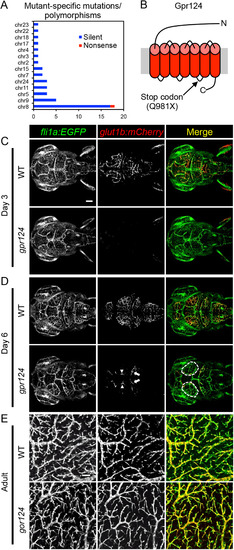Fig. 3
- ID
- ZDB-FIG-170607-8
- Publication
- Umans et al., 2017 - CNS angiogenesis and barriergenesis occur simultaneously
- Other Figures
- All Figure Page
- Back to All Figure Page
|
gpr124 mutants have reduced CNS angiogenesis. (A) Whole-exome sequencing was used to identify the gpr124 mutation. Only one gene on chromosome 8 was found to have a nonsense mutation. (B) A premature stop codon was found in gpr124 resulting in a Q981X mutation located in the intracellular loop between transmembrane domains 5 and 6 (not to scale). (C) At 3 dpf, gpr124 mutants show no CNS angiogenesis and no glut1b:mCherry expression (see Video 2). (D) At 6 dpf, gpr124 mutants form abnormal vessels on the brain surface between the mesencephalic vein and the eye (white dashed outline in Day 6 Merge and Supplemental Figure 1), CNS angiogenesis partially recovered where the mid-cerebral vein sprouts into the parenchyma, and few of these vessels begin to express glut1b:mCherry (arrows), including expression in the mesencephalic vein (arrowheads). The 3D distribution of brain vasculature can be seen more clearly in Video 2. (E) Confocal images of the optic tectum vasculature from wild type (WT) and gpr124 mutant adults at 3 months. Scale bar (C, top left image) is 50 µm for all images in (C) and (D). Scale bar is 100 µm (E, top left image). |
| Genes: | |
|---|---|
| Fish: | |
| Anatomical Terms: | |
| Stage Range: | Protruding-mouth to Adult |
| Fish: | |
|---|---|
| Observed In: | |
| Stage Range: | Protruding-mouth to Day 6 |
Reprinted from Developmental Biology, 425(2), Umans, R.A., Henson, H.E., Mu, F., Parupalli, C., Ju, B., Peters, J.L., Lanham, K.A., Plavicki, J.S., Taylor, M.R., CNS angiogenesis and barriergenesis occur simultaneously, 101-108, Copyright (2017) with permission from Elsevier. Full text @ Dev. Biol.

